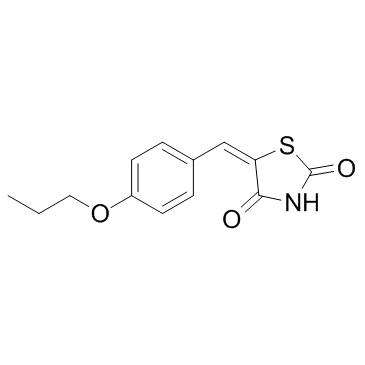| Description: |
SMI-16a is a selective Pim kinase inhibitor with IC50 values of 0.15, 0.02 and 48 μM for Pim1, Pim2 and PC3 cells, respectively. |
| Target: |
IC50: 0.15 μM (Pim1), 0.02 μM (Pim2), 48 μM (PC3 cells)[1] |
| In Vivo: |
Mice tolerate intraperitoneal dose of SMI-16a is 50 mg/kg daily for 5 days, while 100 mg/kg is overtly toxic. Treatment of the animals with SMI-16a for 5 days per week reduces the growth of tumors by approximately 50% and does not cause a loss of body weight. Subchronic dosing with SMI-16a does not affect the levels of red, white blood cells, including lymphocytes, monocytes, and granulocytes, indicating that the compound does not have myelosuppressive effects. SMI-16a does not have toxicity toward the liver as the albumin, alkaline phosphatase, and alanine aminotransferase levels are unchanged [1]. SMI-16a effectively prevents bone destruction while suppressing MM tumor growth in MM animal models[2]. |
| In Vitro: |
SMI-16a has excellent potency for inhibition of both Pim-1 and Pim-2[1]. Treatment with Pim-2 short-interference RNA as well as the Pim inhibitor SMI-16a successfully restores osteoblastogenesis suppressed by all the above inhibitory factors and MM cells. The SMI-16a treatment potentiates BMP-2-mediated anabolic signaling while suppressing TGF-β signaling[2]. |
| Kinase Assay: |
Recombinant human Pim-1 (Upstate) is incubated with S6 kinase/Rsk-2 peptide 2 (KKRNRTLTK) as the substrate in the presence 100 µM of compounds from the screening library, 1 µM ATP and 10 mM MgCl2 for 1 h. The Kinase-Glo luciferase kit is used to measure residual ATP levels after the kinase reaction[1]. |
| Cell Assay: |
Human prostate cancer PC3 cells are seeded in 96-well tissue culture dishes at approximately 10% confluency and allowed to attach and recover for 24 h. Varying concentrations of the test compounds (SMI-16a) are then added to each well, and the plates are incubated for an additional 48 h. The number of surviving cells is determined by the MTS assay. The percentage of cells killed is calculated as the percentage decrease in MTS metabolism compared with control cultures[1]. |
| Animal Administration: |
Mice: Female Balb/C mice are injected subcutaneously with JC cells suspended in PBS. After palpable tumor growth, animals are treated five days per week by intraperitoneal injection of vehicle alone or 50 mg/kg of SMI-16a.Whole body weights and tumor volume measurements are performed three times per week[1]. |
| References: |
[1]. Xia Z, et al. Synthesis and evaluation of novel inhibitors of Pim-1 and Pim-2 protein kinases. J Med Chem. 2009 Jan 8;52(1):74-86.
[2]. Hiasa M, et al. Pim-2 kinase is an important target of treatment for tumor progression and bone loss in myeloma. Leukemia. 2015 Jan;29(1):207-17. |






















